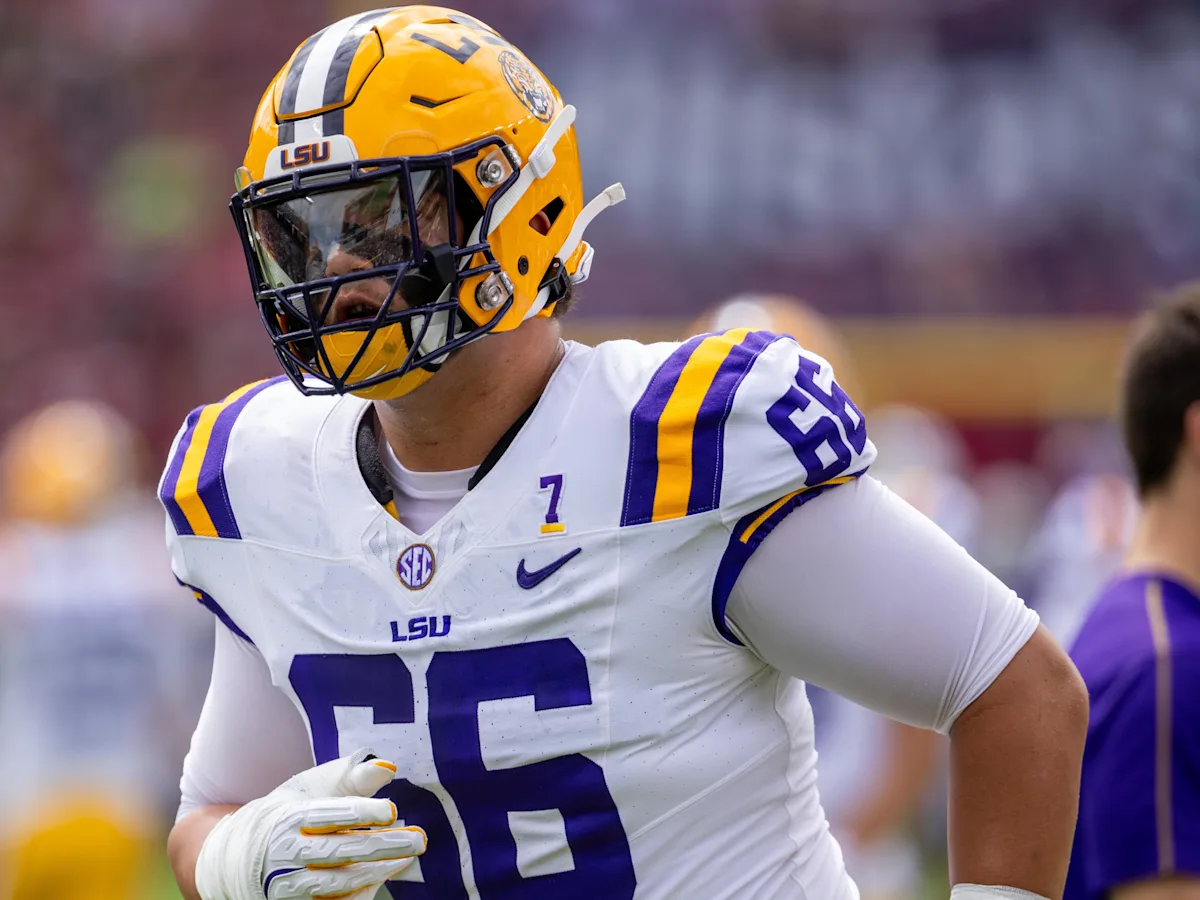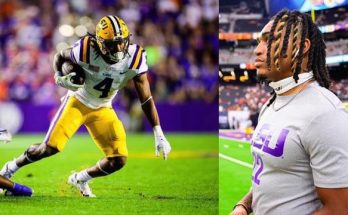Maybe the Chicago Bears won’t have an issue with Will Campbell’s arm length after all.
The Chicago Bears’ interest in potential draft prospects has sparked considerable debate around several key metrics that can define a player’s success at the NFL level. One of the factors that often rises to the top of such discussions is arm length, which, despite being a somewhat overlooked statistic in casual fan circles, is a significant detail in evaluating offensive and defensive linemen. When you look at Will Campbell, an offensive lineman from LSU, the conversation about arm length has gained traction due to the question of whether his dimensions could hinder his performance in the NFL. However, if you take a closer look at Campbell’s overall skill set and the Bears’ approach to building their team, it becomes apparent that arm length might not be as big a concern as some believe.
The Role of Arm Length in Offensive Line Play
Arm length is traditionally viewed as a crucial measurement for offensive linemen, particularly tackles. The logic is simple: longer arms allow players to engage with defenders from a distance, giving them an edge in maintaining leverage and keeping defenders at bay. The shorter the arms, the more difficult it can be to get a solid punch or strike on an opposing player, which can put linemen at a disadvantage in terms of protecting the quarterback or opening running lanes.
Typically, offensive tackles are expected to have arm lengths that fall in the 33-inch range or longer. This is because it allows them to create separation between themselves and the defender, making it easier to control engagements and keep defenders from closing the pocket. As such, many teams view arm length as one of the most important measurements when evaluating a tackle, as it can be a predictor of success in pass protection.
However, this is not a hard-and-fast rule. There are always exceptions to the norm. Some tackles with shorter arms have been successful in the NFL by relying on other skills such as technique, footwork, hand placement, and mental processing. This brings us to the case of Will Campbell, whose arm length has come under scrutiny during the pre-draft process. Will his 33-inch arms be a major hindrance to his success at the next level, or will his other attributes help him mitigate any potential concerns?
Will Campbell’s Background
Before delving into the specifics of his arm length and how it fits into the broader context of his skill set, it’s important to take a step back and examine Will Campbell’s background as a player. Campbell is a highly touted offensive tackle from LSU, a program known for producing NFL talent at nearly every position. Throughout his college career, Campbell has demonstrated a high level of consistency and versatility, making him one of the more intriguing offensive line prospects in the 2025 draft.
Campbell stands at 6-foot-6 and weighs around 320 pounds, giving him ideal size for an NFL tackle. His physical traits align with what scouts typically look for when evaluating prospects at the position. He has the mass and frame to anchor against powerful pass rushers, and his combination of size, mobility, and strength has earned him a reputation as one of the top offensive linemen in the nation.
Despite the skepticism about his arm length, Campbell has proven that he can be a highly effective player in college. He is known for his ability to move defenders off the ball, protect his quarterback, and create running lanes for his team. His performance in both the SEC and against top-tier competition has proven that he is capable of holding his own against some of the best defensive linemen in the country. This raises the question: is arm length truly the game-changing factor that some people believe it is?
Overcoming Arm Length Concerns
The Chicago Bears, under the leadership of general manager Ryan Poles and head coach Matt Eberflus, have shown a clear commitment to building a strong, cohesive offensive line. They’ve focused on acquiring players who fit their scheme and culture, with an emphasis on toughness, technique, and high football IQ. Given their approach, it’s important to recognize that the Bears are likely evaluating players like Campbell not just on physical measurements, but also on their overall ability to contribute to the team.
One of the most important factors in Campbell’s favor is his technique. Despite concerns about his arm length, Campbell has consistently demonstrated an ability to win in the trenches with his refined technique and hand placement. His understanding of leverage, ability to stay balanced, and his punch timing all contribute to his ability to neutralize pass rushers, even without a perfect arm-length measurement. His quickness and lateral mobility have allowed him to get into position quickly, which offsets some of the disadvantages that could come with shorter arms.
Additionally, Campbell’s mentality and awareness on the field set him apart. He has shown that he can adapt to various defensive alignments and adjust his technique accordingly. In many cases, offensive linemen with shorter arms compensate by using quicker hand strikes, better footwork, and a more disciplined approach to staying in front of the defender. This adaptability is something the Bears likely value as they aim to develop a more fluid and versatile offensive line unit.
Campbell’s ability to anchor at the point of attack and hold his ground against powerful rushers, even when his arms don’t necessarily give him the most favorable reach, speaks volumes about his potential in the NFL. When you consider how frequently offensive linemen need to make quick, on-the-fly decisions and adjust to new situations, Campbell’s high football IQ and ability to think critically on the field may well be more important than his arm length.
The Bears’ Needs and Philosophy
Looking at the Bears’ roster, it’s clear that they’re in the midst of a rebuild. After trading away the No. 1 overall pick in the 2025 NFL Draft, the Bears are focusing on adding pieces that can help solidify their long-term success. One of their most pressing needs is along the offensive line, where protecting quarterback Justin Fields is paramount. With Fields’ mobility and dynamic playmaking ability, the offensive line needs to be a unit that can provide both protection in the pocket and the ability to open up lanes for the running game.
In the context of this need, Will Campbell presents a strong option for the Bears. While arm length is a factor in evaluating a player’s effectiveness, it’s important to remember that no single measurement defines a player’s potential. The Bears are likely to take a holistic approach to evaluating Campbell, looking at his complete set of skills and how they fit into their overall vision for the team.
Given Campbell’s success in both pass protection and run blocking, it’s reasonable to assume that the Bears will focus more on his ability to anchor and protect Fields rather than any potential disadvantages caused by his arm length. In the NFL, the ability to adapt to different defensive schemes and to read the game quickly is critical, and Campbell’s proficiency in these areas could make him a better fit for the Bears’ offense than his arm length might suggest.
NFL Success Beyond Arm Length
Several examples of successful NFL players with less-than-ideal arm length prove that it’s not the be-all and end-all when evaluating offensive linemen. Consider players like Russell Okung, a former NFL offensive tackle, whose arm length was considered slightly shorter than average, but who enjoyed a long and productive career. Okung’s success was driven by his quick feet, ability to engage defenders with good hand placement, and excellent pass protection technique.
Similarly, smaller offensive tackles like Jason Peters and even shorter-arm players like Joe Thomas have thrived in the NFL, demonstrating that a strong technique, combined with experience and awareness, can mitigate any disadvantages of shorter arms. These examples show that while arm length is important, it is not a defining characteristic that will determine a player’s success in the league.
Arm Length Isn’t Everything
While it’s easy to focus on arm length as a key concern when evaluating Will Campbell, it’s important to recognize that there are many other factors that contribute to his potential as an NFL player. His technique, footwork, strength, and intelligence on the field make him a worthy prospect for the Chicago Bears. While arm length may be a limiting factor in some cases, it seems less likely to be a decisive disadvantage for Campbell, given his other abilities.
As the Bears continue their rebuild, focusing on a balanced and effective offensive line is critical to their long-term success. Will Campbell’s skill set, combined with his work ethic and adaptability, should give the Bears confidence that his arm length won’t be the issue that some may believe. Instead, his overall game will likely be what makes him an asset to the Bears’ offense moving forward.



